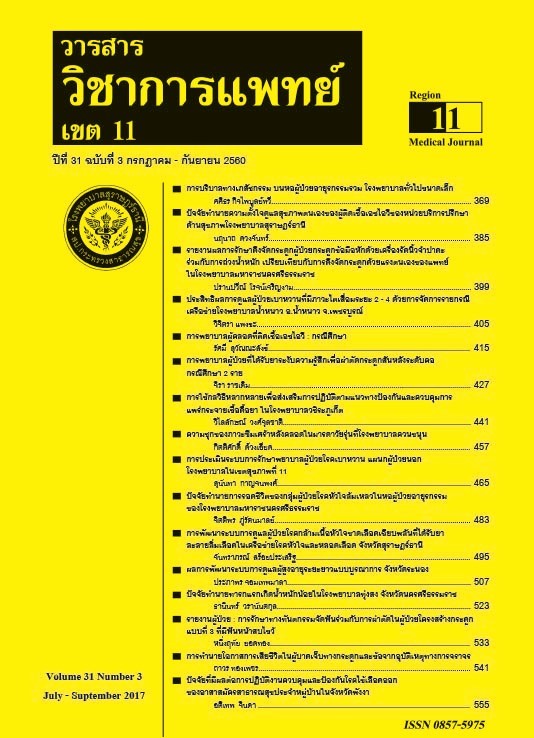Predictive factors of survivals with congestive heart failure at medical units in Maharaj nakorn Si thammarat hospital
Keywords:
Congestive heart failure, survivals;acute MI, AntiarhythmiaAbstract
Objective:To identify the risk factors associated with survival in congestive heart failure at medical wards. Methods : A retrospective review of medical records of 730patients who were diagnoses as congestive heart failure in ICD-10 as I-500 between October 2013-september 2015 was conducted. Fifteen factors were included in univariate and only significant factors were included in multivariate analyses. Results : Population study were conducted730 patients with average age about 66.3 years old(female 403persons in average age 69.5 years old and male 326persons with average age 61.8 years old ).Underlying disease diabetes 43.4% hypertension64.8%and Chronic renal failure30.7%.were reported. Eighty three point seven percent of all admissions were survive .From multivariate analysis,predicted risk factors were associated with Dyslipidemia(P=.029) Chronic renal failure (P<0.001) thalassemia (P=0.27) First presentation as infection(P<0.001) acute myocardial infarction (P<0.001) Septic shock (P<0.001) Pneumonia (P<0.001) medical treatment: Plavix(P<0.001) statin(P=0.008) antiarhhythmic drugs (P<0.001) antianginal (P<0.001) antimicrobial agent(P<0.001) Insulin administration (P<0.001) high dose Lasix(P<0.001) serum Cr ≥1.3mg/dL(P<0.001)and serum albumin<3g/dL (P=0.002). From logistic regression analysis,factors associated with mortality were dyslipidemia(Adj.OR0.4395%CI(0.2,0.94))acute myocardial infarction(Adj.OR .5195%CI(2.43,29.81)) antiarrhythmic drug (Adj.OR 26.82 95%CI(8.77,82.01))serum albumin<3g/dL (Adj.OR1.79 95% CI(1.03,3.12)). Conclusion:Factors as acute myocardial infarction and antiarrhythmic drugs were independent predictive factors increased mortality.
References
2.Cohn, J. N. and T. S. Rector (1988). “Prognosis of congestive heart failure and predictors of mortality.” The American journal of cardiology 62(2): 25A-30A.
3. Gottdiener, J. S., A. M. Arnold, et al. (2000). “Predictors of congestive heart failure in the elderly: the Cardiovascular Health Study.” Journal of the American College of Cardiology 35(6): 1628-1637.
4. Harnett, J. D., R. N. Foley, et al. (1995). “Congestive heart failure in dialysis patients: prevalence, incidence, prognosis and risk factors.” Kidney international 47(3): 884-890.
5. He, J., L. G. Ogden, et al. (2001). “Risk factors for congestive heart failure in US men and women: NHANES I epidemiologic follow-up study.” Archives of internal medicine 161(7): 996-1002.
6. Ho, K., K. M. Anderson, et al. (1993). “Survival after the onset of congestive heart failure in Framingham Heart Study subjects.” Circulation 88(1): 107-115.
7. Jiang, W., J. Alexander, et al. (2001). “Relationship of depression to increased risk of mortality and rehospitalization in patients with congestive heart failure.” Archives of internal medicine 161(15): 1849-1856.
8. Likoff, M. J., S. L. Chandler, et al. (1987). “Clinical determinants of mortality in chronic congestive heart failure secondary to idiopathic dilated or to ischemic cardiomyopathy.” The American journal of cardiology 59(6): 634-638.
9. Lloyd-Jones, D. M., M. G. Larson, et al. (2002). “Lifetime risk for developing congestive heart failure the Framingham Heart Study.” Circulation 106(24): 3068-3072.
10 McKee, P. A., W. P. Castelli, et al. (1971). “The natural history of congestive heart failure: the Framingham study.” New England Journal of Medicine 285(26): 1441-1446.
11. Phillips, C. O., S. M. Wright, et al. (2004). “Comprehensive discharge planning with postdischarge support for older patients with congestive heart failure: a meta-analysis.” Jama 291(11): 1358-1367.
12. Schocken, D. D., M. I. Arrieta, et al. (1992). “Prevalence and mortality rate of congestive heart failure in the United States.” Journal of the American College of Cardiology 20(2): 301-306.
13. Senni, M., C. M. Tribouilloy, et al. (1998). “Congestive heart failure in the community a study of all incident cases in Olmsted County, Minnesota, in 1991.” Circulation 98(21): 2282-2289.
14. Silverberg, D. S., D. Wexler, et al. (2001). “The effect of correction of mild anemia in severe, resistant congestive heart failure using subcutaneous erythropoietin and intravenous iron: a randomized controlled study.” Journal of the American College of Cardiology 37(7): 1775-1780.
15. Smith, W. M. (1985). “Epidemiology of congestive heart failure.” The American journal of cardiology 55(2): A3-A8.
16. Stewart, S., J. E. Marley, et al. (1999). “Effects of a multidisciplinary, home-based intervention on planned readmissions and survival among patients with chronic congestive heart failure: a randomised controlled study.” The Lancet 354(9184): 1077-1083.






